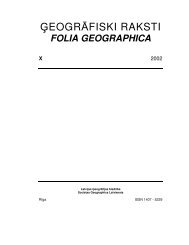eogrÄfiski raksti folia geographica xii - Ä¢eogrÄfijas un Zemes zinÄtņu ...
eogrÄfiski raksti folia geographica xii - Ä¢eogrÄfijas un Zemes zinÄtņu ...
eogrÄfiski raksti folia geographica xii - Ä¢eogrÄfijas un Zemes zinÄtņu ...
You also want an ePaper? Increase the reach of your titles
YUMPU automatically turns print PDFs into web optimized ePapers that Google loves.
9<br />
GENERAL TRENDS<br />
learned societies.A scholar was a devoted scientist whose aim was to find the truth and to<br />
promote <strong>geographica</strong>l discoveries. Academies were the main scientific institutions. On the other<br />
hand, along with the establishment of new <strong>un</strong>iversities in the early 19 th century, teaching and<br />
research were integrated together and first chairs of geography were established (Figure 1).<br />
The emergence of geography as <strong>un</strong>iversity discipline was linked to the early 19 th century<br />
Humboldtian ideals of civilization in which the aim of <strong>un</strong>iversity was to search for truth through<br />
the interaction between teachers and students. The autonomy of the <strong>un</strong>iversity would guarantee<br />
the means, methods, and scope of research. This is close to the Habermasian notion of science<br />
with practical humanistic interest, where the aim is to expand knowledge through<br />
comm<strong>un</strong>ication [Habermas 1971]. However, in the latter part of the 19 th century the seemingly<br />
innocent “what is where” <strong>geographica</strong>l research was used to build up and strengthen the then<br />
emerging nation-states [Capel 1981].<br />
The second, the “applied geography period” period, started from the late 19 th century<br />
onwards. During that period the scope of geography expanded and the discipline emerged as a<br />
normative tool. Besides the academy and the <strong>un</strong>iversity, the figure of the geographer was<br />
connected to specialized institutes devoted fully to research; and to applied colleges devoted to<br />
teaching, and to a lesser extent, also research [Granö 1997] (Figure 1).<br />
The idea of this new geography as an applied technical field of study can be interpreted as<br />
a certain interaction and merging of interest between government and science. Following the<br />
early 20 th century Weberian notions about the role of the <strong>un</strong>iversity, science is an important field<br />
through which one can find clear technical solutions for problems of society. The idea of a<br />
<strong>un</strong>iversity is not to be involved in political life or to decide what is right or wrong in society.<br />
The aim of the researcher – a geographer, for instance – is to find the truth or the applied<br />
solutions for specific problems. Later on politicians decide to implement those solutions that are<br />
deemed to be good for the nation [Habermas 1971]. This is linked also to the notion of science<br />
as having a technical and rational activity whose aim is to reproduce society [Habermas 1971].<br />
Geography, as many other disciplines during the 20 th century, became a useful normative tool to<br />
help the governments of established nation-states to organize and use their national resources<br />
most efficiently [Capel 1981].<br />
During the third, the “contemporary geography period”, from the latter part of the<br />
20 th century onwards, the activities in the discipline expanded further. Geography emerged as a<br />
contracting and consulting activity in national and international research projects and programs<br />
in and outside the <strong>un</strong>iversity [Granö 1997]. Geographers became appointed to the positions of<br />
project researcher, planner of research co<strong>un</strong>cils and manager of broad (inter)disciplinary<br />
research framework programs (Figure 1). This is linked to the idea of the <strong>un</strong>iversity as an<br />
enterprise that is able to market and sell knowledge. It was fo<strong>un</strong>d that often it was enough to<br />
reflexively modify existing knowledge for particular social and economic contexts, so that<br />
basic, f<strong>un</strong>damental research declined in many fields. Universities became socially and<br />
economically fully responsible for their activities and research output was continuously<br />
evaluated for its pragmatic relevance. The aim of inter-, trans- and post-disciplinary research<br />
programs at the <strong>un</strong>iversity was to produce new applied knowledge. In short term this can direct<br />
the attention away from seminal scientific research.<br />
One such trend is the Research Framework Programs of the European Union (EU) that is<br />
a cornerstone of EU science policy. Collaborative networks of scientists within the EU have<br />
proliferated rapidly and joint projects, research infrastructure, and institutes have become<br />
common. According to Frenken (2002, 568), smaller and more peripheral co<strong>un</strong>tries of the EU<br />
are increasingly integrating into large research framework programs by reducing their national<br />
orientation in research over time. Larger and more central co<strong>un</strong>tries in the EU are today better<br />
integrated in the inter-EU research programs and research collaboration. Scale advantages<br />
obviously render larger co<strong>un</strong>tries more attractive partners than smaller co<strong>un</strong>tries.<br />
Geographical publishing and the production of knowledge<br />
Geographical knowledge is “textual”, divided between written texts, visual elements such<br />
as pictures, photos, and maps, and <strong>un</strong>written everyday experience. There is need for

















